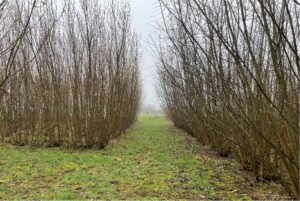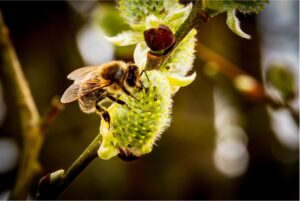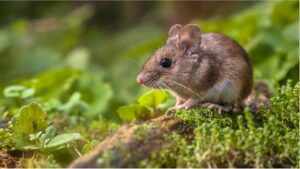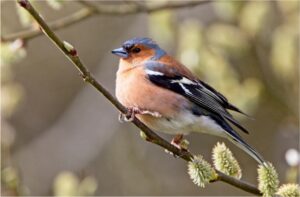How does Short Rotation Coppice (SRC) willow affect biodiversity?
Key messages
- Short Rotation Coppice (SRC) willow plantations support high plant and animal species diversity in comparison to arable land.
- The abundance and richness of biodiversity in SRC willow is associated with the crop and its management, the plantation size and layout design, and interaction with surrounding landscapes.
- Planting different, small, multi-genotype plots and different age classes of SRC willow, with different coppice rotations enhances biodiversity.
- SRC willow stand edges have higher plant and animal species diversity compared to the stand edges of other arable crops.
- The low input use and low soil disturbance after the establishment of SRC willow plantations provide a conducive environment for many plant and animal species to survive.
Introduction
The production of biomass crops such as short rotation coppice (SRC) willow, is an important part of the UK’s Net Zero strategy to generate more homegrown renewable heat and electricity and biomass feedstocks for non-bioenergy uses. SRC willow is a short rotation woody crop that rapidly produces large amounts of renewable biomass that is harvested every two to five years. It provides environmental benefits of minimising soil erosion and increasing wildlife habitat and biodiversity for birds, pollinators and small mammals.
The large-scale deployment of willow is hampered by concerns that the extensive commercial production of SRC willow could have negative effects on biodiversity. In this article, we provide insights into the design and management of SRC willow plantations and measures to enhance plant and animal biodiversity.
SRC willow and plant diversity
SRC willow contributes to plant diversity when integrated into existing landscapes and farming systems. Studies[1] have shown that SRC willow plantations support a high level of plant species richness and abundance in comparison to arable land. For example, a study[2] found 27% more plant species (133 flora species) and a greater weed cover in SRC willow plantations when compared to the neighbouring arable agricultural land. The low input use and low soil disturbance after establishment of SRC willow plantations[3] provides a conducive environment for many plant species to survive.
Plant species colonisation in an SRC willow plantation occurs as a result of the indigenous seed bank, and through living vegetation tissues like rhizomes, tillers, or living roots in the soil. In the initial years of establishment, the plant diversity is similar to typical arable fields, but as the SRC willow plantation ages, the plant diversity evolves to replicate a deciduous forest. However, the regular coppicing of the SRC plantation limits this process.
The layout and size of the SRC willow plantation and interaction with surrounding landscapes affects plant biodiversity. Studies[4] suggest that biodiversity is enhanced by:
- Having small plots separated by buffer strips to maximise the edge effect.
- Plantations composed of a mix of genetically diverse varieties.
- Staggering the harvesting of different plantations over several years, ensuring a continuous availability of different age structures.
A study showed that plant species richness increased with increasing size of a SRC plantation but only until a size of 0.1–0.3 ha was reached. Small plot sizes with enhanced edge effect lend themselves to agroforestry applications[5] such as buffer strips, shelter belts and wildlife corridors. Different genotypes of the willow plant differ in the morphology of shoot, branches, and leaves. This creates niches for diverse plant and animal habitats.
Furthermore, the plant density and harvesting regime of the SRC willow influences the dynamics of the canopy closure which influences the plant species richness and abundance. In the initial years of establishment more light demanding plant species, usually annual species with shrub-like herbaceous structure, grow under the crop. As the canopy further closes with increasing age, more shade tolerant perennial plants typical of deciduous forest[6] are likely to be present.
SRC willow and animal diversity
SRC willow plantations provide a dynamic habitat which is suitable for different bird and mammal species. Young plantations attract birds and animals associated with open fields, but as the willow ages and increases in height, it attracts animals associated with woodland habitats. Unlike plant species where the place of establishment on the willow field provides all the nutrients needed by the plant, animals seldomly rely completely on SRC willow for fulfilling all their habitat needs[1]. They use the willow for one or more function of shelter, nesting, and foraging.
Different genotypes of willow grow in distinct ways, creating varied habitats that attract different types of wildlife. For example, certain bird species are drawn to the branching structure of some willow varieties, while the herbaceous growth during the early years of establishment attracts small mammals and insects. Willow plantations also serve as wildlife corridors, connecting adjacent or fragmented landscapes, which is beneficial for species movement and biodiversity. These corridors act as vital conduits, allowing wildlife to traverse and thrive in otherwise isolated areas.
Invertebrates
Willow plantations provide habitat and sustenance for a large diversity of invertebrates such as bees, spiders, butterflies and ground beetles. Willow provides pollen and nectar early in spring (sometimes as early as January) to the end May for bees to build and sustain their colonies.
Male willow catkins produce pollen, while female catkins produce both pollen and nectar, upon which bees and other pollinators forage for food. Willow sex is a key factor in the differences in bee visitation. A study found that male willow supports a greater abundance and diversity of bees compared to female willow[7]. Careful selection of both male and female willow is important to provide pollen at different flowering times, extending the availability of food for pollinators throughout the season.
Furthermore, minimising soil disturbance after willow establishment benefits earthworm populations[8]. Other studies have found that arthropod activity densities[9] are significantly higher, sometimes nearly double, in SRC willow plantations compared to arable land. Additionally, species richness and butterfly abundance are higher in SRC willow plantations. SRC willow also positively impacts biodiversity quality, particularly among ground beetles and arachnids[9].
Pesticide use is a known factor in the decline of insect abundance and diversity[10]. However, the low input required for managing SRC willow allows many insect species to thrive. Harmful pests, such as Chrysomelid beetles, can be controlled by planting intimate mixtures of genetically diverse willow varieties. This practice helps prevent population explosions, as beetles prefer to lay eggs where they feed and are less likely to travel beyond their preferred willow type.
Mammals
Willow plantations host a high abundance and diversity of mammals[11], including wood mice, (Apodemus sylvaticus), common shrew (Sorex araneus), field vole (Microtus agrestis), and many others. The herbaceous nature of the willow crop and its harvesting regime provide a semi-long-term habitat for mammal species typically associated with open fields and meadows. Many small mammals are particularly attracted to willow in the year following coppicing[11], due to the increased herbaceous undergrowth. Coppicing promotes the growth of weedy flora, which offers a food source for these small mammals. A UK study[12] indicated that willow plantations become especially suitable habitats for small mammals when the plantation is allowed to become weedy.
Smaller mammals only require small spatial niches. Willow plantations, even smaller ones, are therefore able to provide small mammals with all their habitat needs. Large mammals on the other hand, with their wider spatial niches, may not find sufficient habitat within the willow plantation alone and must rely on the surrounding landscape to meet their needs. Studies[11] have also shown that dominant small mammal species from adjacent woodlands can successfully survive in willow plantations.
Birds
Willow plantation attracts numerous woodland and other types of bird species[13] such as chaffinch, long-tailed tit, robin, dunnock, wren, blackbird, song thrush and many others including some red and amber bird species. A survey of an SRC willow plantation in Wales recorded 25 bird species both in the breeding season (April to September) and winter, sighting birds such as blackbird, goldfinch, redpoll, and song thrush, nesting in SRC willow plantation.
Some bird surveys carried out by Biomass Connect at an SRC plantation in North Devon recorded 19 species that were seen or heard in the crop (see adjacent table). This included one red-listed species (linnet) and seven amber-listed species, including summer migrants such as willow warbler and sedge warbler.
The abundance of bird species in SRC willow plantations is influenced by factors such as age, coppice stem structure, planting density, and weed cover. Different bird species select different age classes of SRC willow to meet their habitat needs. As the crop ages, changes in height, canopy cover, and ground cover create varied environments. While small mammals often prefer willow crops in the year following coppicing due to the herbaceous undergrowth, birds are more likely to use older willow crops. Planting a mix of different age classes within a plantation helps provide a diverse habitat for a wide range of bird species.
Studies have shown that bird nesting habitat can be further enhanced by incorporating specific varieties of SRC willow[14] that are particularly favoured for nesting. The surrounding landscape also plays a key role in shaping bird composition within the crop. Research suggests that situating plantations near woodlands, copses, and hedgerows can significantly increase bird species richness and abundance[15].
To maximise biodiversity, SRC willow plantations should be carefully planned and managed. Landowners and managers should consider the following:
Wider Stand Edges[5]: Incorporate stand edges of at least 6 meters in width into the plantation design. Actively manage these edges by allowing naturally occurring plants to colonise or by planting seeds to promote plant biodiversity. This will support a diverse range of wildlife, including pollinators and small mammals.
Multi-Genotype Stands[14]: Establish small, multi-genotype stands within the plantation, with varying coppice rotation lengths. This diversity will enhance habitat variety, benefiting different species and promoting overall biodiversity.
Minimise or Avoid Pesticide Use[10]: Avoid or minimise the use of pesticides, as they can severely impact non-target invertebrates, leading to a decline in biodiversity. Instead, planting mixed stands with six or more diverse willow varieties can be a more effective strategy for controlling pest infestations.
Conclusion
SRC willow positively impacts both plant and animal biodiversity. The abundance and richness of biodiversity within SRC willow plantations are influenced by factors such as crop management, plantation size and layout, and interactions with surrounding landscapes. The low input requirements and minimal soil disturbance after establishment create a favourable environment for a wide range of plant and animal species to thrive.
Planting small, multi-genotype plots with varying age classes and coppice rotation lengths enhances biodiversity by providing diverse habitats. The edges of SRC willow stands, in particular, tend to have higher species richness and abundance. These stand edges should be actively managed by allowing naturally occurring plants to colonise or by purposefully planting seeds to maximise plant biodiversity and support various animal species, including pollinators and small mammals.
References (in order of appearance)
- https://www.sciencedirect.com/science/article/pii/S1364032119303181
- https://www.osti.gov/etdeweb/biblio/20249914
- https://www.sciencedirect.com/science/article/abs/pii/S096195341000303X?fr=RR-2&ref=pdf_download&rr=8c15d8ec6882368d
- https://www.ieabioenergy.com/blog/publications/quantifying-environmental-effects-of-short-rotation-coppice-src-on-biodiversity-soil-and-water/
- https://onlinelibrary.wiley.com/doi/full/10.1111/j.1757-1707.2010.01058.x
- https://www.sciencedirect.com/science/article/abs/pii/S096195341000303X?fr=RR-2&ref=pdf_download&rr=8c15e2de18179407
- https://www.sciencedirect.com/science/article/abs/pii/S0961953418301843?fr=RR-2&ref=pdf_download&rr=8c15f470dd8abed2
- https://www.mdpi.com/2073-4395/9/11/675
- https://www.sciencedirect.com/science/article/abs/pii/S0961953414002931
- https://conbio.onlinelibrary.wiley.com/doi/10.1111/csp2.80
- https://www.sciencedirect.com/science/article/abs/pii/S0961953412003662
- https://www.sciencedirect.com/science/article/abs/pii/S0961953497100551?fr=RR-2&ref=pdf_download&rr=8c16179ade8f63d3
- https://onlinelibrary.wiley.com/doi/full/10.1111/j.1474-919X.2006.00522.x
- https://www.sciencedirect.com/science/article/abs/pii/S0961953404000807
- https://www.sciencedirect.com/science/article/abs/pii/S0167880901002122








